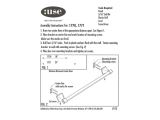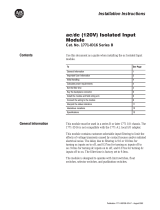Rockwell 1771–P5 Installation Instructions Manual
- Category
- Power supply units
- Type
- Installation Instructions Manual
Rockwell 1771–P5 is a power supply module that can be used in both series A and B 1771 I/O chassis. It has a controlled “soft-start” feature to enhance power supply reliability and provides 8A of output current. The 1771–P5 is compatible with a variety of processors, including 1772ĆLSP1, 1772ĆLWP1, 1772ĆLXP1, and 1771ĆAL. It can also be paralleled with another 1771–P5 to provide increased power capacity. Power loss time delay can be set to provide a delay from when the power supply input voltage drops below 20.
Rockwell 1771–P5 is a power supply module that can be used in both series A and B 1771 I/O chassis. It has a controlled “soft-start” feature to enhance power supply reliability and provides 8A of output current. The 1771–P5 is compatible with a variety of processors, including 1772ĆLSP1, 1772ĆLWP1, 1772ĆLXP1, and 1771ĆAL. It can also be paralleled with another 1771–P5 to provide increased power capacity. Power loss time delay can be set to provide a delay from when the power supply input voltage drops below 20.




















-
 1
1
-
 2
2
-
 3
3
-
 4
4
-
 5
5
-
 6
6
-
 7
7
-
 8
8
-
 9
9
-
 10
10
-
 11
11
-
 12
12
-
 13
13
-
 14
14
-
 15
15
-
 16
16
-
 17
17
-
 18
18
-
 19
19
-
 20
20
Rockwell 1771–P5 Installation Instructions Manual
- Category
- Power supply units
- Type
- Installation Instructions Manual
Rockwell 1771–P5 is a power supply module that can be used in both series A and B 1771 I/O chassis. It has a controlled “soft-start” feature to enhance power supply reliability and provides 8A of output current. The 1771–P5 is compatible with a variety of processors, including 1772ĆLSP1, 1772ĆLWP1, 1772ĆLXP1, and 1771ĆAL. It can also be paralleled with another 1771–P5 to provide increased power capacity. Power loss time delay can be set to provide a delay from when the power supply input voltage drops below 20.
Ask a question and I''ll find the answer in the document
Finding information in a document is now easier with AI
Other documents
-
Allen-Bradley series b Installation Instructions Manual
-
Allen-Bradley B Series Installation Instructions Manual
-
 USE 1771.24 Installation guide
USE 1771.24 Installation guide
-
Allen-Bradley 1771-IL Installation Instructions Manual
-
Allen-Bradley 1771-OBN Installation Instructions Manual
-
Allen-Bradley 1771-OWN Installation Instructions Manual
-
 Rockwell Automation 1771-ID16 Installation Instructions Manual
Rockwell Automation 1771-ID16 Installation Instructions Manual
-
Allen-Bradley 1771-ODD Installation guide
-
Allen-Bradley C Series Installation guide
-
Allen-Bradley 1771-OG Installation Instructions Manual





















